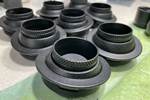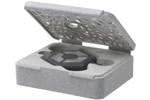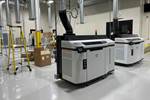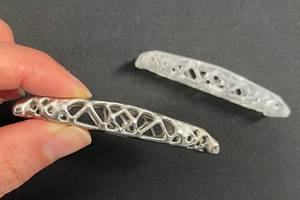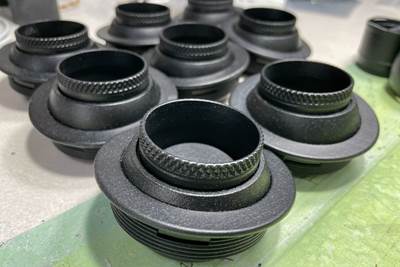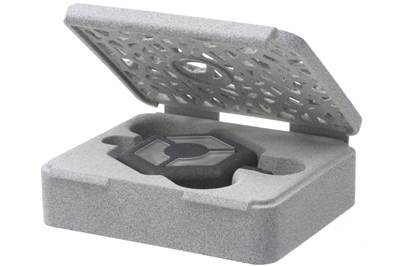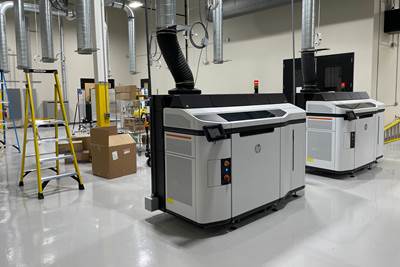Inside Avid Product Development’s facility in Loveland, Colorado, the company’s six Multi Jet Fusion (MJF) 3D printers hum along in two tidy rows, printing parts in nylon and TPU (specifically, Lubrizol TPU — more on that in a moment) . Unpacking stations line the walls, and off to the side sits a newer, automated unpacking machine that extracts parts and reclaims powder without human supervision. Multiple build units stand ready to be swapped into a printer at a moment’s notice. In adjacent rooms, specialized equipment for smoothing, polishing and dyeing MJF prints provides low-touch, repeatable finishing.
Avid Product Development operates six Multi Jet Fusion printers, and has multiple build units ready to swap in or out (seen on the shelf in the foreground). Creating efficiency in the workflow around 3D printing leaves its engineering team more free to focus on steps before and after part manufacturing.
The production floor is sparsely populated, and there is a set-it-and-forget-it feel to the space that signals efficiency. Much of the work of printing, unpacking and postprocessing individual parts has been automated through the capacity above, leaving the company’s team of mostly engineers free to do other things — design and redesign parts for additive, interface with customers, engineer workflows for new products, and devise solutions to downstream process challenges. Because while part production is largely optimized and automated, the company is engaged not just in delivering 3D printed parts, but finished products.
True to its name, Avid Product Development’s manufacturing capacity is primarily devoted to prototypes and product development, with bridge and serial production making up a smaller portion of the company’s work. The automation and efficiencies the company has invested in are thus dedicated largely to high-mix, low-volume manufacturing, even in most production cases, rather than to mass production of a few repeating parts.
Creating this versatile efficiency enables the company to serve long-standing customers as effectively as clients bringing their first products to market, and to also support the postprocessing, finishing and assembly steps that finished products require. I recently visited Avid to learn how the company strikes this balance using additive manufacturing.
Engineering Expertise from Development Through Production
Ryan Billson describes to me the value of the depowdering station pictured here. Although the machine requires about as much time as a human to unpack a build, it also sets an engineer free for that period to work on the more complex aspects of AM such as part design and finishing.
Avid Product Development has its roots in a consulting company started by Doug Collins; Ryan Billson joined Collins as cofounder in 2016. The two mechanical engineers developed a business around product development, design and prototyping with 3D printing. The company acquired its first industrial 3D printers, two HP 4200 Multi Jet Fusion machines, in 2017 and quickly filled the printers with orders. While product development has always been part of the company’s name and DNA, the addition of this industrially focused AM capacity represented a shift in the balance of work, to support production as well as development. It also kicked off a growth spurt.
“We started adopting automation at our old location because we didn’t have room for more people,” Billson says, citing some of the postprocessing machines listed above. “It was about space initially. We couldn’t scale otherwise.”
The business grew and was acquired by materials supplier Lubrizol in 2020; Avid moved to its current location in 2022 and today employs 25 at its 13,500-square-foot-facility. Most of the headcount is still made up of mechanical engineers, whose expertise is key to both developing products and moving them into production.
Avid’s primary role within Lubrizol is to serve as engineering expertise for 3D printing with the latter’s materials — but this happens alongside its normal activities as a parts provider. Avid Product Development operates relatively independently much as it always has, and while the company commonly prints with Lubrizol’s thermoplastic polyurethane (TPU), it is free to use other polymers from other material manufacturers as the application dictates. Rather than a captive manufacturing operation, Avid is something like a powerhouse of 3D printing expertise that Lubrizol and its material users can tap into.
“We act as a full engineering team that can do end-to-end development,” Billson says, “whether Avid, Lubrizol or a third party ends up printing the final parts.”
Dawson Swan, engineering manager, holds out one of many Lubrizol TPU lattice samples that Avid has designed and tested. The rig behind him was custom built to test the impact performance of various 3D printed lattices (more examples of which are lined up on top of the machine).
Balancing Prototyping and Production
While Avid’s specialty is in the initial development of parts and products, the company balances this activity now with production work, much of which is ongoing, repeat orders.
“We get more orders for prototyping, but most of our revenue comes from production runs,” says Brittney Frank, sales developer.
One of the largest of these ongoing production jobs is an electronics enclosure that Avid 3D prints with MJF. While the part design is fairly simple and could be suitable for injection molding at the quantities needed, the client requires enclosures that can fit a range of products and support ongoing design changes. Avid retains this job as additive production because of the variety required, the fact that the enclosure parts nest easily into an MJF build, and the value-added services it can provide to the customer.
The electronics enclosure (not pictured in this article) is placed inside this custom fixture for the installation of metal inserts. Avid installs somewhere around 10,000 inserts per month.
For example, after printing and postprocessing are complete, Avid Product Development installs multiple heat-fit inserts into each enclosure, placing somewhere around 10,000 inserts per month. Again, the company’s penchant for creating efficiencies is evident — to make the installation easier, the engineering team has developed specialized jigs that make it possible to quickly heat each area of the part with a soldering iron and place the inserts.
Sales developer Brittney Frank shows how each cranial helmet enables swapping out the panels, so that the same custom device can be used longer term throughout multiple stages of care.
Other production jobs embody the concept of mass customization, such as cranial remolding orthoses used to correct head shape in infants. Produced for Invent Medical, each orthosis resembling a helmet is custom-made and features a two-in-one design. The frame can hold two different pop-in panels that can be swapped out depending on the stage of care. Avid Product Development has a turnaround time of just 48 hours for these patient-specific items.
While recurring production work like this is growing, the company nonetheless retains its specialty in helping customers get new products off the ground. One such product Avid has helped develop is called “The Overcomer,” sold by School Specialties.
Swan demonstrates how the Overcomer device works. A bat, racket or similar piece of equipment can be affixed to the top of the joint with Velcro straps, which the user can swing by pushing or pulling the adjustable handle seen here in its horizontal position.
This gear assembly featuring multiple 3D printed MJF parts is key to the advantage provided by the Overcomer.
The device is a motion amplifier that enables individuals with mobility challenges to swing athletic equipment such as a golf club, hockey stick or teeball bat by moving a lever rather than handling the object directly. The adaptive sports device is constructed from extruded aluminum (sourced from a supplier) and about 15 different nylon 3D printed parts that Avid manufactures. A printed planetary gear assembly inside the primary joint provides a five-to-one rotational advantage, making it easier for the user hit the ball or puck farther.
The Overcomer’s creator came to Avid Product Development with an initial design that he wanted to make affordable and manufacturable. Avid worked with the client to dial in the design so that it would be suitable for MJF and producible at the desired price point. Today the company manufactures the device as needed in an end-to-end process, from printing the key components to final assembly in-house.
What sets Avid apart is often not 3D printing itself, but the lengths the company will go to in fulfilling the other needs of the product. For this portable EEG device which monitors brainwave activity, the engineering team set up a finishing line and devised fixtures to precisely coat 10 sensor inserts at a time with a conductive coating.
Managing High Variety
Supporting everything from product development through serial production means that Avid Product Development prints and manages a wide range of parts each week. The company has developed strategies around this fact that help ensure that each part is successfully printed, handled and tracked according to its final application.
While some Avid customers order parts in the hundreds and thousands, the majority of its production looks more like this — smaller lots of a range of parts.
CO-AM software from Materialise is used to manage data about every part, including the machine it was printed on and the lot of powder it was produced from. Each part is inspected right after printing and depowdering to ensure that only good parts go on to polishing, dyeing or additional postprocessing.
But for the variety of parts Avid manufactures, the pursuit of quality begins well before printing in how builds are nested and batched. Avid prefers to keep production runs and like parts together in the same batches. This makes downstream processing more straightforward, Billson explains, because each build must be handled according to its most delicate part. Mixed batches that include parts of varying wall thickness and feature sizes can lead to unnecessary slowdowns in unpacking and postprocessing to avoid damaging the less robust items.
Another consideration to batching effectively is managing the thermal load inside the printer by carefully considering the density of each build of parts.
“We shoot for about 12% packing density with PA12 nylon,” Billson says, by way of example. Keeping density relatively high ensures that space is used efficiently within the envelope, and helps the build heat (and cool) evenly for prints with reliable quality.
A Different Take on Automation
While Avid Product Development has ongoing production that can be considered high-volume such as the electronics enclosures, most of its work involves high-mix, low-volume manufacturing — and the company is comfortable with this. Despite the range of parts and unique workflows attached to each product, Avid Product Development has put in place tools that make it possible to automate and ensure consistency across batches and jobs.
Generally speaking at Avid Product Development, parts that print together stay together throughout postprocess steps such as dyeing (with equipment from Girbau and DyeMansion, above) and vapor smoothing (in this PostPro3D from AMT).
While the facility doesn’t house any robots or other obvious signs of automation, Avid is a clear example of how the right equipment, software and procedures can set human engineers free to perform high-value tasks, because the tedious and repetitive ones are largely handled. Automated unloading allows engineers to walk away, design the next project or finish the previous one while parts are excavated from the powder. Specialized dyeing machines from Girbau and DyeMansion, and AMT PostPro3D and SF50 systems for vapor smoothing, help the company provide consistent, predictable surface finishes by utilizing repeatable programs, rather than expecting operators to consistently execute recipes in a homegrown dye station, for instance. Avid Product Development can be an expert in product development, partly because it has become so efficient at production.
That’s why developing the end-to-end workflow for new products is worthwhile, even if they will go on to be made in some other way. For items like the Overcomer, which is needed in low volumes, and the infant helmets, which could only be made custom on such a short timeline additively, Avid Product Development will carry on as the production provider through additive manufacturing. But for many more of the products it sees through development, the company will help to hand off production to a different provider (sometimes, the client will take 3D printing capacity in-house) or to a different process.
The majority of products that come through Avid Product Development will not stay additive, Billson says, and that’s ok. Nevertheless, the company is looking toward a future that involves more additive manufacturing, specifically more production of end-use parts. When I visited, the company was preparing to add a seventh 3D printer to its space, and Billson revealed that there is room for as many as a dozen of these machines in the future.
Related Content
How Electroplating Works for Polymer 3D Printed Parts
Baltimore-based RePliForm specializes in electroplating of 3D printed polymer parts for functional applications. This video explores how the process works, and potential benefits and uses for this technique.
Read MoreVulcanForms Is Forging a New Model for Large-Scale Production (and It's More Than 3D Printing)
The MIT spinout leverages proprietary high-power laser powder bed fusion alongside machining in the context of digitized, cost-effective and “maniacally focused” production.
Read MoreCopper, New Metal Printing Processes, Upgrades Based on Software and More from Formnext 2023: AM Radio #46
Formnext 2023 showed that additive manufacturing may be maturing, but it is certainly not stagnant. In this episode, we dive into observations around technology enhancements, new processes and materials, robots, sustainability and more trends from the show.
Read MorePossibilities From Electroplating 3D Printed Plastic Parts
Adding layers of nickel or copper to 3D printed polymer can impart desired properties such as electrical conductivity, EMI shielding, abrasion resistance and improved strength — approaching and even exceeding 3D printed metal, according to RePliForm.
Read MoreRead Next
Finding the Serial Production Wins for Polymer Additive Manufacturing
Aerosport Additive is aiming to grow its serial production work by seeking out the niches where AM materials, costs and capabilities align — challenging the notion that “production” of plastic parts always means molding.
Read MoreCan Additive Manufacturing Materials Challenges Be Solved with Design?
TPU manufacturer Lubrizol says yes: Production-ready materials are here, and 3D printing-enabled design has only begun to realize their capabilities.
Read MoreWhat Does Additive Manufacturing Readiness Look Like?
The promise of distributed manufacturing is alluring, but to get there AM first needs to master scale production. GKN Additive’s Michigan facility illustrates what the journey might look like.
Read More

.jpg;width=70;height=70;mode=crop)
